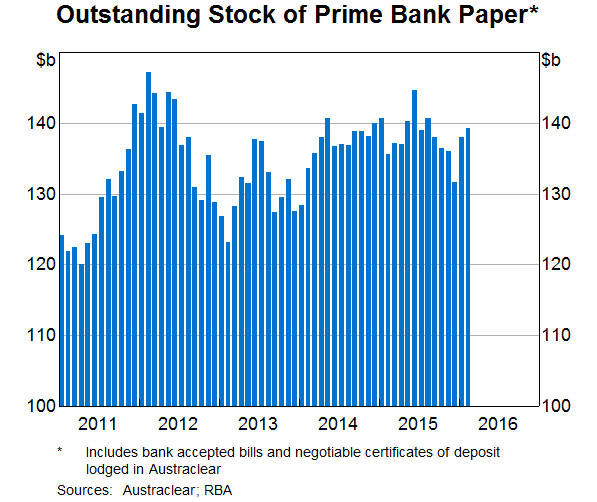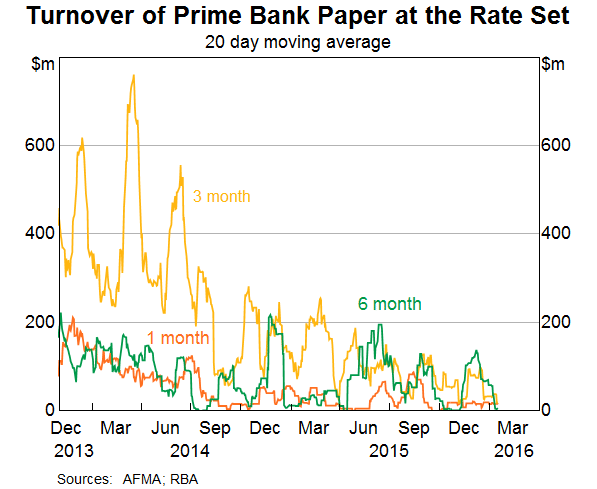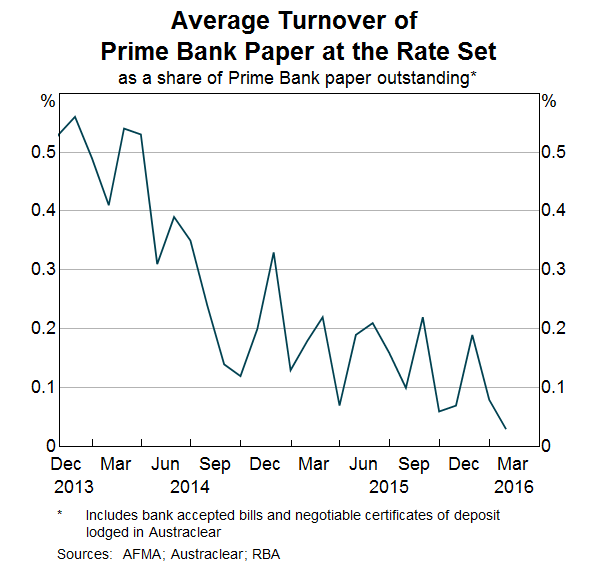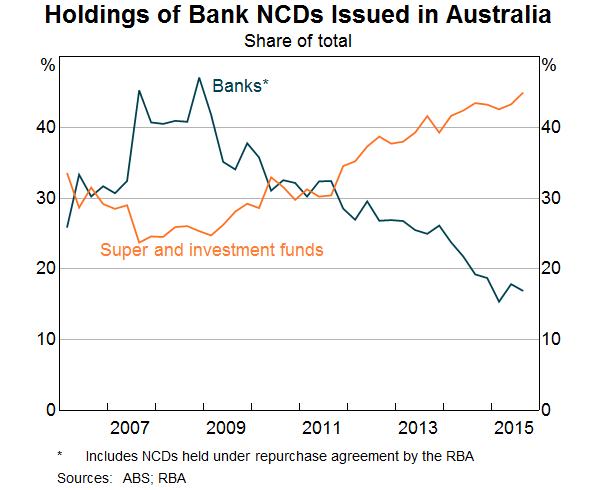Speech Interest Rate Benchmarks

Guy Debelle[*]
Assistant Governor (Financial Markets)
KangaNews Debt Capital Markets Summit 2016
Sydney –
- Audio 15.4MB
- Q&A Transcript
Today I am going to talk again about interest rate benchmarks, as there have been some important recent developments.[1] These benchmarks are very much at the heart of the plumbing of the financial system. They are widely referenced in financial contracts. For example, the interest rate on a corporate loan is often a spread to an interest rate benchmark. Many classes of derivative contracts generally are based on them, as are most asset-backed securities. In light of the issues around London Inter-Bank Offered Rate (LIBOR) and other interest rate benchmarks, there has been a global reform effort under the aegis of the Financial Stability Board (FSB) and the International Organization of Securities Commissions (IOSCO) to improve the functioning of interest rate benchmarks.[2]
I will focus on domestic reforms around the principal interest rate benchmark in Australia, the bank bill swap rate (BBSW). I will also mention plans underway to introduce a ‘risk-free’ interest rate for the domestic market, as a complement to BBSW. I will not talk about the investigations that ASIC is currently undertaking into conduct around BBSW.
Reforms to the BBSW Methodology
As you may be aware, in recent months, the Council of Financial Regulators (CFR) has been conducting a consultation on possible reforms to the BBSW methodology.[3] I will run through the motivation for doing so, outline the key issues that have been raised in the consultation, and put forward some proposed reforms for market participants to consider.
Given its wide usage, BBSW has been identified by ASIC as a financial benchmark of systemic importance in our market.[4] It is important there is ongoing confidence in it. Without that, we have a serious problem, given its integral role in the infrastructure of domestic financial markets.
As you may know, BBSW was calculated for a number of years by, each day, asking a panel of banks to submit their assessment of where the market was trading in Prime Bank paper at a particular time of the day. While it was a calculation based on submissions, it differed from LIBOR in that BBSW submitters were asked about where the market for generic Prime Bank paper was trading that day. In contrast, LIBOR submitters were asked about where they thought their own bank's cost of funds was that day.
In response to the prospect of a large number of the participants on the submission panel no longer being willing to provide submissions, the calculation of BBSW was reformed in 2013 in line with the IOSCO Principles for Financial Benchmarks, which were issued in July 2013.[5]
Since 2013, the Australian Financial Markets Association (AFMA) has calculated BBSW benchmark rates as the midpoint of the (nationally) observed best bid and best offer (NBBO) for Prime Bank Eligible Securities, which are bank accepted bills and negotiable certificates of deposit (NCDs). Currently, the Prime Banks are the four major Australian banks. The rate set process uses live and executable bid and offer prices sourced from interbank trading platforms approved by AFMA, These platforms are currently ICAP, Tullett Prebon and Yieldbroker. The bids and offers are sourced at three points in time around 10.00 am each day.
While the outstanding stock of bills and NCDs issued by the Prime Banks has increased since 2013 to around $140 billion (Graph 1), trading activity during the daily BBSW rate set has declined over recent years to very low levels (Graphs 2 and 3). There are quite a number of days where there is no turnover at all at the rate set. The low turnover in the interbank market raises the risk that market participants may at some point be less willing to use BBSW as a benchmark. This is the motivation for the CFR's consultation to ensure that BBSW remains a trusted, reliable and robust financial benchmark.



There is considerably more activity in the NCD market than is being measured at the rate set, with the activity mainly occurring outside the interbank market. Given the size of the market and the short maturity of the securities, on average over $1 billion in NCDs are issued each day. Some preliminary data collected from the four major Australian banks indicate that this issuance is regular, with at least $100 million in NCDs bought or sold on almost all business days at the one, three and six-month tenors. However, the non-bank participants that buy and sell NCDs tend to transact bilaterally with the issuing bank, with the price struck at the (yet to be determined) BBSW rate, rather than at a directly negotiated rate. If these participants could be encouraged to buy and sell NCDs at outright yields, then these transactions would have the potential to make the BBSW benchmark more robust.
Consistent with there being a shift in NCD trading activity to outside the interbank market, banks' holdings of NCDs as a share of total issuance has declined over recent years to below 20 per cent (Graph 4). Over the same period, there has been a steady increase in holdings by super and other investment funds, with their share of NCD issuance rising to almost half recently.

As part of the consultation, the CFR received 15 written submissions from a wide range of market participants, including the Prime Banks, NCD investors, and users of BBSW as a benchmark. We have also spoken directly with market participants to better understand what has caused the decline in trading activity during the rate set and to discuss potential solutions. To bring all this together, the CFR recently released a discussion paper for AFMA and market participants to consider, which summarises the views of market participants and proposes some improvements to the BBSW methodology.[6]
Most market participants share our concern about the low trading volumes during the rate set and acknowledge that changes to the BBSW methodology will be necessary. But before making any changes, it is crucial to understand why so little trading has been occurring during the rate set. Four key reasons were put forward by market participants:
- First, institutions face a potential conflict of interest when they participate in the market underpinning a benchmark as well as the derivatives market that references the benchmark. Many institutions state they are uncertain about how regulators expect these conflicts to be managed. As a result, they are reluctant to trade during the rate set.
- Second, managers of money market funds are reluctant to trade at outright yields during the rate set. They prefer to agree the volume of their bill transactions with a Prime Bank before 10.00 am and set the rate after 10.00 am at BBSW, since this minimises their tracking error against their benchmark.
- Third, investors subject to credit limits are reluctant to trade during the rate set where bills are traded as a homogeneous asset class, as they could be delivered the bills of a Prime Bank for which they have already used up their credit limit.
- Finally, foreign bank branches have less demand for bank paper than in the past since it is not considered a high-quality liquid asset under the Liquidity Coverage Ratio either in Australia or in their home jurisdictions.
Despite these challenges, it is crucial that BBSW remain a trusted, reliable and robust financial benchmark given its importance to the financial system. To ensure this, the CFR has put together a proposal for the evolution of the BBSW methodology, taking into account the feedback provided through the consultation process. In putting forward this proposal, the key objectives are to ensure that:
- BBSW is anchored to observable arm's length transactions in an active underlying market;
- the BBSW calculation mechanism is robust to changing market conditions;
- the fundamental properties of BBSW are maintained to ensure a seamless transition for financial contracts as the methodology evolves.
While most participants are in favour of some changes to the methodology, there are many features of the existing methodology where there is consensus that they should be retained. In particular, there was broad support that the securities underlying BBSW continue to be the NCDs and bank bills of the Prime Banks, as they are relatively homogeneous and liquid. As a result, we don't need to go down the path of calculating BBSW as a broader measure of banks' short-term wholesale funding, as is being considered for LIBOR and Euro Interbank Offered Rate (EURIBOR). This avoids the risk of there being a significant change in the characteristics of BBSW which could lead to contract frustration.
To boost activity during the rate set, most submissions supported broadening the definition of the underlying market beyond the interbank market to include transactions with a wider range of counterparties, such as investment funds and the treasury corporations. These submissions highlighted that there is much more activity in the market prior to the rate set than during the rate set. This activity prior to the rate set has the potential to underpin BBSW, assuming market participants agree to transact at directly negotiated rates rather than at BBSW. Given the much larger role that non-banks play in the market, we agree that it is time to widen the underlying market beyond the interbank market to include such counterparties. There is a risk that activity in the interbank market alone will not be sufficient to support the calculation of BBSW, and the credibility of the benchmark would be enhanced by the participation of counterparties that come from outside the banking sector.
The key change to the methodology proposed by many of these submissions was to calculate BBSW directly from market transactions, rather than using the NBBO method. That is, calculating BBSW as the volume-weighted average price (VWAP) of market transactions during the rate set window. Given the objective is to better anchor BBSW to transactions in the underlying market, we support moving the calculation methodology to the VWAP.
Calculating the VWAP should be feasible for the one, three and six-month BBSW tenors, since these are the most liquid. The Prime Banks issue three and six-month NCDs on almost a daily basis, and there is an active market in buying back one month NCDs. If there were to be insufficient transactions to calculate the VWAP at these tenors, NBBO was widely supported by market participants as an appropriate fall-back methodology.
However, there is unlikely to be sufficient liquidity in the underlying market at the two, four and five-month tenors to reliably calculate the VWAP, so we propose that these tenors be calculated by interpolation from the more liquid tenors.
While there was solid support for the VWAP methodology, there was a wide range of views as to how the transactions during the rate set should be executed. Three methods proposed were:
1. Direct negotiation between Prime Banks and investors, with issuance and secondary market transactions being negotiated and executed in terms of outright yields, most likely over the phone. A rate set window of around 60–90 minutes (for instance, from 8.30 am to 10.00 am) should provide sufficient time for such transactions to take place.
2. An electronic trading market, with transactions being executed on the trading platforms where the Prime Banks and investors post bids and offers in terms of outright yields for a particular Prime Bank's NCDs. A rate set window of around 30–45 minutes (for instance, from 9.15 am to 10.00 am) should be sufficient.
3. A tender process, with the issuance and secondary trading of each Prime Bank's NCDs taking place in terms of outright yields through an auction. Given that all the transactions would be executed at the same time, the rate set window could be quite short (for instance, bids and offers could be submitted over a 15-minute period, with the tender closing at 10.00 am).
Each of these methods has its advantages and disadvantages. Conducting the transactions over the phone is flexible and is most similar to current market practice, so it would be unlikely to require extensive changes to systems and procedures. However, it would be the least transparent, which may discourage participation from investors and necessitate more oversight of the conduct of market participants. An electronic trading market would also be able to facilitate a wide range of transactions while significantly improving market transparency. However, the platforms currently only serve the inter-bank market, so other participants would need to change their systems and procedures. Finally, a tender would probably have the shortest rate set window, reducing basis risk for investors and minimising the length of time that the Prime Banks are required to make prices. However, the design of the tender would be quite complex to support a wide range of transactions such as switch trades (where, for instance, an investor simultaneously sells NCDs with a one-month tenor and purchases those with a six-month tenor). This may lead some market participants to be reluctant to participate.
While none of these execution methods is clearly superior to the others in all dimensions, the market will need to eventually coalesce around one of them to maximise the amount of activity during the rate set. To me, the methods involving trading on electronic platforms are the most attractive, given the associated visibility and transparency that comes with trading across a platform. However, to ensure that BBSW remains robust in the near term, it may be necessary for market participants to continue transacting over the phone but at outright yields, and for the benchmark administrator to use these transactions to calculate the VWAP.
Regardless of which method for executing the transactions is chosen, the key challenge is going to be to get investors to be more comfortable with transacting a significant share of their NCD transactions at directly negotiated rates. Maintaining BBSW as a robust benchmark is clearly in everyone's best interest, including the Prime Banks, since many of their loan contracts reference BBSW, and the investment funds, since BBSW is their performance benchmark. So to some extent, we should be able to rely on the survival instincts of all participants in the market to encourage more activity during the rate set. This is why we are proposing that the market convention should be for the Prime Banks to conduct their primary issuance and secondary market trading in terms of outright yields during the rate set window.
Nevertheless, the current lack of trading activity during the rate set suggests that there may need to be more explicit incentives to encourage participation in the rate set, particularly from a broader range of NCD investors. Assuming the market shifts to trading on the electronic platforms, the improvement in market transparency that would result may be enough to encourage more buy-side participation.
We note that some submissions suggested more onerous alternatives. For instance, one way to ‘encourage’ investors to transact at outright yields would be for the Prime Banks to charge a fee for Eligible Securities transactions negotiated at the BBSW rate. Alternatively, if the bulk of market activity continues to take place outside the rate set window, the Administrator could keep widening the window, which at the extreme could be a 24‑hour period to ensure that all market activity is within scope. We do not support these alternatives at this stage, as they would not be in the best interests of investors. However, if activity during the rate set continues to be too low to sustain BBSW in the medium term, then these alternatives may need to be reconsidered.
So the key questions that we are left with are:
- First, how should the transactions be executed during the rate set window for BBSW to be calculated as the VWAP?
- Second, will market participants be willing to transact at directly negotiated rates rather than at BBSW?
These questions are the focus of our continuing discussions with AFMA and market participants.
While the CFR has an ongoing interest in BBSW as a systemically important financial benchmark, the ultimate responsibility for the BBSW methodology, and the implementation of any changes, resides with the administrator of the benchmark. The CFR appreciates that AFMA and market participants will need to give the proposal in the discussion paper further consideration, and that any associated changes to market practice and infrastructure will take time to implement. As a result, it will be necessary for the current BBSW methodology to be maintained for a period.
To support this process, we have put forward a timeline for consideration of the proposal by AFMA and market participants as well as the implementation of changes by the administrator. We would like to see AFMA complete any further consultation and finalise a set of amendments to the BBSW methodology by the middle of this year, and for the changes to be implemented by the end of this year – although we acknowledge that the feasibility of this timeline will depend on the scope of the amendments to the methodology that are eventually implemented.
Risk-free Rates
Next I would like to briefly raise some issues around whether the use of BBSW needs to be quite as widespread as it is. In a number of instances, BBSW has become the default reference rate without much thought being given as to whether it is the most appropriate reference rate. BBSW is a credit‑based reference rate. It is based on the borrowing costs of the major banks, with the credit risk that entails embodied in the rate.
For a number of purposes, a credit‑based rate is completely appropriate. However, for other purposes, a rate that is closer to risk‑free may be more appropriate. For instance, in recent years, market participants have moved to use overnight-indexed swap (OIS) rates more often when discounting the cash flows in their swaps. The FSB, through its official sector steering group (OSSG) on benchmark reform, is encouraging market participants to contemplate switching from credit‑based benchmark rates like BBSW or LIBOR to risk‑free rates, where appropriate.
In the local market, there appears to be growing interest in using risk-free rates as benchmarks. Such a rate could be backward looking, like the cash rate, or forward looking, like OIS rates. As a first step, some market participants have indicated that a total return index of the cash rate would be a useful backward-looking benchmark. Implementing this would be straightforward, since the RBA already calculates and publishes the cash rate. Some market participants are also interested in referencing a forward-looking rate with equivalent tenors to BBSW, and we will continue to work with AFMA on the development of such a benchmark.
One example where a change in reference rate could be contemplated is for floating rate notes (FRNs) issued by governments. FRN coupon payments are typically priced at a spread to BBSW. While referencing BBSW makes sense for FRNs issued by banks, it is less clear why governments should tie their coupon payments to a measure of bank funding costs.
That is one example worthy of consideration. There are a number of others. I know this is not necessarily an issue you may have thought that much about until now. At the very least, I would encourage you to at least ask the question whether the product you are issuing or holding is using the most appropriate reference rate.
Conclusion
Let me conclude. Interest rate benchmarks such as BBSW are a very critical part of the plumbing of the financial system. Market participants need to have confidence in their robustness and integrity. To help ensure that is the case, the CFR has undertaken a consultation process on the BBSW methodology. The industry, working through AFMA and with the CFR, will need to act on these proposals to ensure that BBSW remains a trusted, reliable and robust financial benchmark.
Endnotes
I would like to thank Ellis Connolly for assistance in the preparation of these remarks. [*]
Debelle G (2015), ‘Benchmarks’, Address to Bloomberg Summit, Sydney, 18 November. [1]
See Financial Stability Board (2014), ‘Reforming Major Interest Rate Benchmarks’, July, available at <http://www.financialstabilityboard.org/wp-content/uploads/r_140722.pdf>; and Financial Stability Board (2015), ‘Progress in Reforming Major Interest Rate Benchmarks’, Interim Report on Implementation of July 2014 FSB Recommendations, July. Available at <http://www.financialstabilityboard.org/wp-content/uploads/OSSG-interest-rate-benchmarks-progress-report-July-2015.pdf>. [2]
See Council of Financial Regulators (2015), ‘The Evolution of the BBSW Methodology’, Consultation Paper, October. Available at <http://www.cfr.gov.au/publications/consultations/evolution-of-the-bbsw-methodology/>. [3]
See Australian Securities & Investments Commission (2015), ‘Report 440 Financial benchmarks’, July. Available at <http://download.asic.gov.au/media/3285136/rep440-published-8-july-2015.pdf>. [4]
See International Organization of Securities Commissions (2013), ‘Principles for Financial Benchmarks’, Final Report, July. Available at <https://www.iosco.org/library/pubdocs/pdf/IOSCOPD415.pdf>. AFMA's assessment of its processes against these principles can be found at <http://www.afma.com.au/data/iosco-principles>. [5]
See Council of Financial Regulators (2016), ‘The Evolution of the BBSW Methodology’, Discussion Paper, 9 February. Available at <http://www.cfr.gov.au/publications/consultations/evolution-of-the-bbsw-methodology/discussion-paper.pdf>. [6]